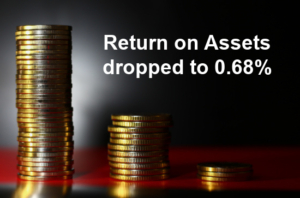By Douglas Hall, Founder & CEO, EQUE
2023 proved challenging for US credit unions. As the economic landscape shifted, these financial institutions faced unprecedented obstacles, resulting in record-low earnings, growing fraud challenges and heightened concerns.
There is one often-overlooked way to enhance profitability while vastly reducing fraud. Let’s explore the possibilities.
Earnings Declined

In Q4 of 2023, credit unions experienced one of the toughest three-month periods in recent history, according to a report by Callahan & Associates. Their return on average assets (ROA) dropped to just 0.68%, the lowest since 2011. During the Great Recession, ROAs ranged between 0.63% and 0.50%. The struggle to maintain profitability intensified as credit unions faced challenges on multiple fronts.
The only way to improve earnings is by reducing expenses, finding new sources of revenue or new members, or relying on the Federal Reserve to intervene with interest rates – but that may not happen until the fourth quarter.
The CECL Accounting Challenge
Implementing the Current Expected Credit Loss (CECL) accounting standards played a significant role. Credit unions had to set aside substantial provisions for potential loan losses. In fact, their loan loss allowances reached a staggering $1.53 for every dollar in delinquent loans. This cautious approach showed the industry’s dedication to prudent risk management but also heavily impacted their financial well-being. Credit unions must invest more in technology, data management, and advanced reporting tools.
Operating Obstacles

Liquidity constraints, margin pressures, and a decrease in non-interest income added to the impact. Callahan & Associates said credit unions struggled to find a balance between serving their members and maintaining their stability. The delicate balance between operational efficiency and member satisfaction became increasingly complicated. Larger issues like increased fraud and high interest rates also affected credit unions and their cardholders.
Fraud Challenges and Opportunities
I have a unique perspective on how credit unions can improve their financial results – from an unlikely source: fraud and risk management. According to Alloy’s 2024 State of Fraud Benchmark of Report, 79% of decision-makers surveyed at credit unions and community banks reported direct fraud losses of over $500,000 in 2023 – the highest among all segments in the survey.
However, there is some good news – financial institutions are planning to invest in fraud prevention technologies, such as identity risk solutions (76%), biometrics (57%), document verification software (54%), anti-scam education tools (54%), machine learning (30%), and alternative data vendors (25%).

A fraud solution like EQUE’s dynamic CVV technology can prevent 75% or more of card-not-present and friendly fraud and significantly reduce false declines. For credit unions with significant fraud losses, this could save millions of dollars in fraud losses and significantly reduce operational costs, time, and resources needed to manage chargebacks and other fraud-related issues.
A Look into 2024
The 2024 outlook remains cautious. Callahan CEO Jon Jeffreys predicts another challenging year for credit unions. The obstacles continue, and the industry must quickly adapt to changing economic conditions. Credit unions are navigating through rough waters.
Implementing effective fraud management will lower operational costs, contributing to overall profitability. While the storm may eventually pass, the lessons learned in 2023 will shape credit union strategies for years ahead.
About the Author

Douglas Hall is the CEO and Founder of EQUE Corp, an innovative e-commerce fraud prevention service that uses dynamic CVV technology to create “person present”transactions, eliminating card-not-present and friendly fraud and significantly reducing false declines. He is a prominent leader in the global payments industry with decades of experience in finance, a serial entrepreneur, and the publisher of PaymentsNEXT.

